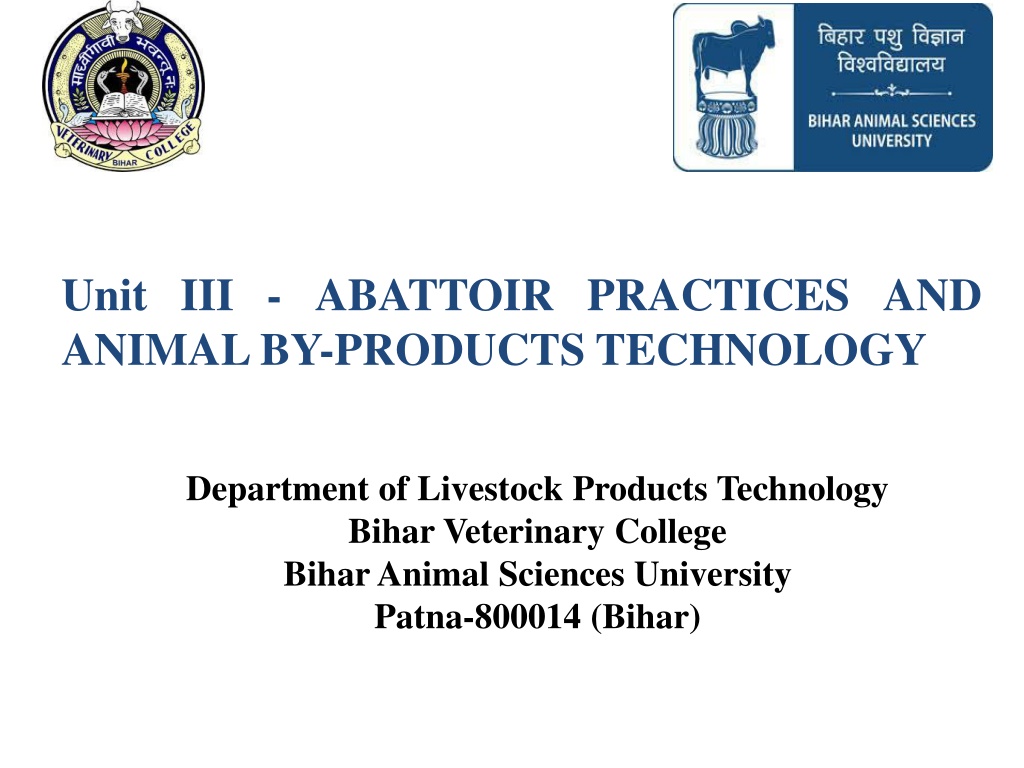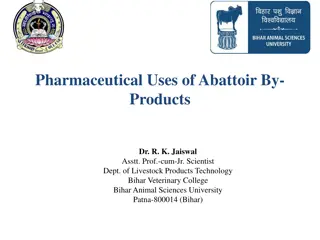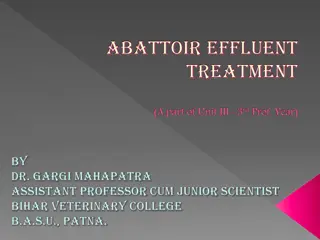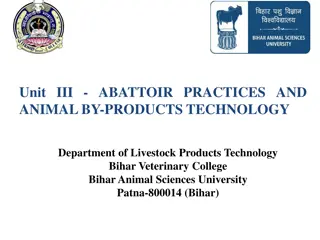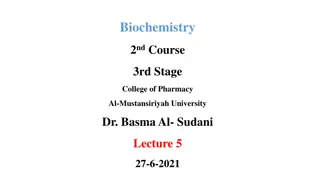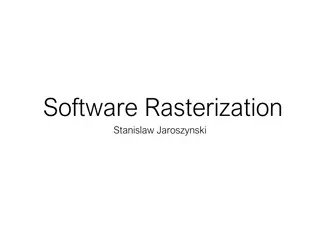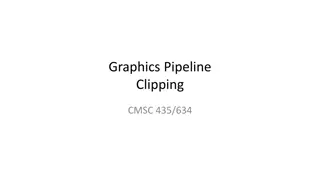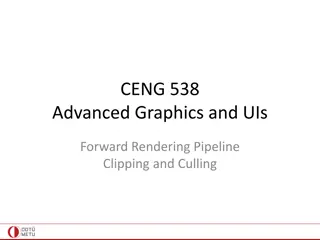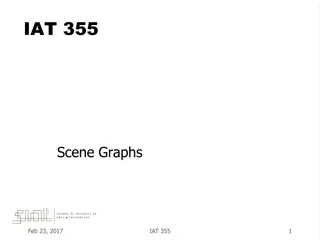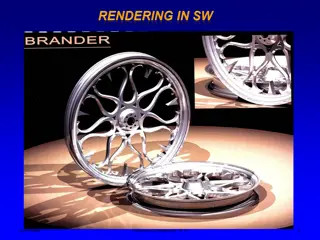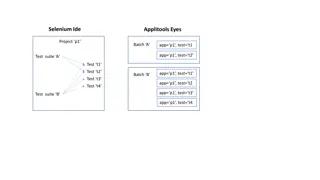Understanding Rendering in Abattoir Practices
Rendering is the process of fat recovery from animal materials, involving heating or steam treatment to obtain sterilized material for stock feed. Dry and wet rendering methods are used, with differences in pressure and cooking times, resulting in products like tallow and lard. Quality assessment of rendered fat is based on factors like Titre, Free Fatty Acid, and FAC color.
Download Presentation

Please find below an Image/Link to download the presentation.
The content on the website is provided AS IS for your information and personal use only. It may not be sold, licensed, or shared on other websites without obtaining consent from the author. Download presentation by click this link. If you encounter any issues during the download, it is possible that the publisher has removed the file from their server.
E N D
Presentation Transcript
Unit III - ABATTOIR PRACTICES AND ANIMALBY-PRODUCTS TECHNOLOGY Department of Livestock Products Technology Bihar Veterinary College Bihar Animal Sciences University Patna-800014 (Bihar)
Rendering It is the process of recovery of fat from animal materials by heating process or it may be the processing of carcass with heat or steam so as to obtain a nearly sterilized material without any loss of nutrients The resultant dried and ground material serves as a very good stock feed Technical fat is also recovered in this process (Technical fat: the animal fat obtained from animals, which are not incorporated into feed or food chain but are used for other technical purpose like soap making)
Types of rendering 1. Dry rendering Dry renderer is utilized which is made up of horizontal steam jacket with raw materials or load capacity of 8-10 quintals 2-3 Stirrers keep the materials continuously in motion for uniform heat distribution to avoid charring The steam remains in the outer jacket does not come in direct contact of the raw materials or charge
Cont. Materials cooked at 75psi for 3-4 hours in its own moisture No loss of nutrients The resultant materials called cracklings/greaves in the tank Yield is nearly 20% higher than wet rendering Average conversion ratio is 3:1
Cont Wet rendering Wet renderer is utilized which is vertical type equipment Steam directly comes in contact with raw materials or charge Materials cooked at 40 psi for 4-8 hrs. After processing the tankage/slush are allowed to settle for 2 hrs. The fatty materials which floats on the top is removed first then the water then tankage The fat recovery is better Average conversion ratio is 4:1
Products of Rendering Tallow Tallow is referred to as the rendered fat of cattle and sheep with a titre of greater than 40 C (104 F) Lard Lard is the rendered fat of the hog with a titre less than 40 C (104 F)
Test for quality estimation of rendered fat Quality of animal fat both edible and inedible is judged by Titre Free fatty acid (FFA) FAC colour (standard set up by the Fat Analysis Committee of the American Oil Chemists Society) Lovibond colour Moisture Impurities (insoluble) Unsaponifiable matter (MIU)
Titre It refers to the softness or hardness of animal fats expressed as the temperature at which the fatty acids of the given fat solidify Solidification points of animal fats, or titres, are as follows: 1. Pig: 36-40 C 2. Cattle: 42-45 C 3. Sheep: 44-48 C
Free Fatty Acid (FFA) It is usual to express FFA as a percentage of free oleic acid of total sample weight. The amount of FFA in a tallow is an indication of the degree of spoilage that has taken place. AFOA specifications require the FFA to be not more than 2%.
Fat Analysis Committee Colour Fats can vary in colour. They can be almost white to yellow. They can also be green, brown, or red. Colour can be affected by breed, feed, age, condition, and location of livestock. Green colour in tallow comes from contact with gut contents, i.e., the chlorophyll in digested plant. In dry rendering, overheating will give tallow a reddish appearance. The presence of blood will give tallow a brownish discoloration.
Moisture, Impurities (Insoluble), and Unsaponifiable Matter Moisture Pure fat is virtually free of moisture. However, moisture is a necessary agent in the cleaning of offal, and raw material in the cleaning process absorbs water if allowed to stand for lengthy periods. Water in tallow is undesirable because it acts as a medium for the growth of bacteria and the action of fat splitting enzymes. If bacteria are injected into dry fat, most will perish on account of lack of moisture. Moisture level of around 0.2% are desired.
Impurities (Insoluble) Raw fat may contain 90-95% of fatty material and the balance is tissue. This tissue, together with other foreign materials such as protein fines, finely ground bone, hair and manure, constitutes the main impurity of tallow. Other impurities may be in the form of colloidal fines from the gut contents, which may not be removed by settling or centrifuging.
Impurities (Oil Soluble) These soluble impurities include trace elements such as copper, tin (from brass) and zinc. Also includes polyethylene, which melts in the cooking process and dissolves in the tallow. Dissolved polyethylene normally settles and burns onto the coils, particularly if steam is the heating agent, and forms an insulating barrier. Polyethylene in inedible grades of tallow has become so prevalent that standards had to be set. The maximum is 50 parts per million.
Unsaponifiable matter It is the fatty material in a tallow that cannot be converted into a soap by the use of an alkali (i.e., no fatty acids are released by alkali treatment). Small quantities occur naturally in a fat. Cholesterol is one naturally occurring unsaponifiable fat. It is unsaponifiable material of a mineral source, such as lubricating oils and greases from pumps and machinery, that create the greatest problems and are regarded as a direct contaminant by the soap manufacturer.
Other tests Other tests may be conducted by buyers to ascertain properties of purchased tallow include: (1) Saponification number and iodine value The saponification number indicates the average length of fatty acid chains. The iodine number indicates unsaturation. The iodine value is low for animal fats and high for vegetable oils. the degree of
(2) Peroxide value The peroxide test is used to determine the rancidity of a tallow. If the peroxide value is low, this normally suggests that the tallow has not become rancid and will have good stability. Fresh fats have a peroxide value of 1-2, whereas rancid fats have a peroxide value of 15-20. Rancidity is caused by oxidation and hydrolysis.
(3) Smoke point Smoke point has a direct relationship with FFA and is the temperature to which the fat may be heated before it begins to smoke. Approximate smoke points are as follows: Tallow with an FFA of 0.2% : 225 C Tallow with an FFA of 1.0% : 145 C Tallow with an FFA of 5.0% : 120 C
